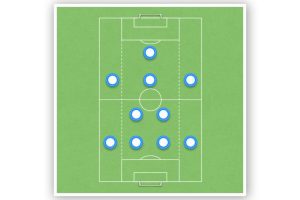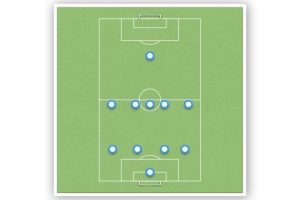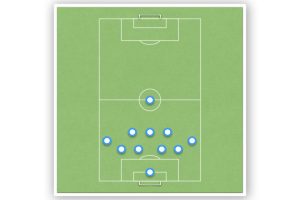Mastering the False Nine in 4-3-3 Formation
A false nine is a unique position in soccer that has gained significant popularity in recent years. It is a type of center forward who drops deep and joins the midfield in possession, rather than lurking around the box for scoring opportunities. The false nine is typically used in a 4-3-3 formation or in other variations such as a 4-1-4-1.
The false nine position requires a player with exceptional movement, dribbling skills, vision, and passing skills. Players in this position need to be able to find pockets of space between the midfield and attack and create opportunities for their team. Without these key attributes, they are unlikely to make a success of the role.
The false nine position is designed to be offensive and can be used to great effect against teams that are defensively strong. It is a position that requires high intensity and off-the-ball movement. Teams that employ the false nine position can force the opposition back by making the most of this aggressive lineup. The 4-3-3 formation is the most commonly used formation for the false nine position, and it has been utilized by top teams such as Spain, Germany, Barcelona, Liverpool, and Chelsea in recent years.
What is a False Nine?
A False Nine is a soccer position that is used in a 4-3-3 formation. It is an attacking role that is utilized by a player who is not a conventional striker. Instead of playing as a traditional center-forward, the False Nine looks for pockets of space between the midfield and attack. The False Nine is a deep-lying forward who operates between where a traditional number 9 center forward and a playmaker number 10 would usually play.
The False Nine position is often played by a player who has a combination of skills, including good ball control, dribbling, and passing. The player in this position is expected to drop deep to receive the ball, draw defenders out of position, and create space for the wingers to exploit. The False Nine is also responsible for linking up with midfielders and wingers, creating scoring opportunities for themselves and others.
The False Nine position has become increasingly popular in modern soccer, with some of the world’s best teams and players using it to great effect. One of the most notable examples of the False Nine in action was Lionel Messi during his time at Barcelona. Messi was deployed as a False Nine by then-manager Pep Guardiola, and the tactic proved to be hugely successful, with Messi scoring a record-breaking 91 goals in a calendar year.
| Advantages of the False Nine Position | Disadvantages of the False Nine Position |
|---|---|
| Creates space for wingers to exploit | Can leave the team vulnerable to counterattacks |
| Draws defenders out of position | Requires a player with a specific skill set |
| Allows for more fluid attacking play | Can be less effective against teams that sit deep and defend |
The 4-3-3 Formation
The 4-3-3 formation is a popular tactical system used in modern football. It is known for its attacking nature and flexibility, allowing teams to both control the midfield and press high up the pitch. The formation consists of four defenders, three midfielders, and three forwards.

Basic Formation
The basic formation of the 4-3-3 involves four defenders, three midfielders, and three forwards. The goalkeeper is not included in the formation, but is typically positioned behind the four defenders. The four defenders are usually split into two center-backs and two full-backs. The center-backs are responsible for marking the opposition’s forwards, while the full-backs provide width and support in both attack and defense.
The three midfielders are typically split into a defensive midfielder, a central midfielder, and an attacking midfielder. The defensive midfielder is responsible for protecting the defense and breaking up opposition attacks. The central midfielder is responsible for controlling the midfield and distributing the ball to the forwards. The attacking midfielder is responsible for creating chances and supporting the forwards in attack.
The three forwards are usually split into a center forward and two wingers. The center forward is responsible for scoring goals and holding up the ball. The wingers are responsible for providing width and creating chances for the center forward.
Role of the Midfielders
The midfielders play a crucial role in the 4-3-3 formation. The defensive midfielder is responsible for protecting the defense and breaking up opposition attacks. This player must be strong in the tackle and have good positional awareness. The central midfielder is responsible for controlling the midfield and distributing the ball to the forwards. This player must have good passing ability and be able to read the game well. The attacking midfielder is responsible for creating chances and supporting the forwards in attack. This player must have good dribbling ability and be able to make runs into the box.
One of the benefits of the 4-3-3 formation is that it allows for a lot of flexibility in midfield. The midfielders can switch positions and cover for each other, allowing for a more fluid style of play. This can make it difficult for opposition teams to mark and defend against.
| Pros | Cons |
|---|---|
| Attacking outlook | Can be vulnerable to counter-attacks |
| Flexible midfield | Requires disciplined defensive midfield |
| Good for pressing | Requires pacey wingers |
The False Nine in 4-3-3
Positioning
The false nine is an attacking role that is used in a 4-3-3 formation. The false nine position is typically played by a player who is comfortable with the ball at their feet and has good vision and passing ability. The false nine’s positioning on the field is crucial to the success of the formation. The player will often drop deep into midfield to receive the ball and link up with the attacking midfielders or wingers. This creates space for the wingers to run into, and also draws defenders out of position, opening up gaps in the opposition defense.
Roles and Responsibilities
The false nine has a unique set of roles and responsibilities in a 4-3-3 formation. The player is responsible for dropping deep into midfield to receive the ball, linking up with the attacking midfielders and wingers, and creating space for them to run into. The false nine is also responsible for creating goal-scoring opportunities for themselves by making runs into the box, and by playing one-twos with the other attackers.
Advantages
One of the main advantages of the false nine in a 4-3-3 formation is that it creates a lot of space for the wingers to run into. This is because the false nine will often drop deep into midfield, drawing defenders out of position and opening up gaps in the opposition defense. The false nine is also a versatile player, capable of playing as a traditional striker, an attacking midfielder, or even a deep-lying playmaker.
Disadvantages
One disadvantage of the false nine in a 4-3-3 formation is that it can leave the team without a traditional striker. This means that the team may struggle to score goals if the false nine is not able to create goal-scoring opportunities for themselves or for the other attackers. Another disadvantage is that the false nine may be isolated from the rest of the team if they drop too deep into midfield, leaving the team without a focal point in attack. Overall, the false nine in a 4-3-3 formation is a versatile and effective attacking strategy that can create a lot of space for the wingers to run into. However, it also has its drawbacks, and requires a player who is comfortable with the ball at their feet and has good vision and passing ability.
Famous Examples
The false nine position has been used by many successful teams in modern football. One of the most famous examples is Barcelona under the management of Pep Guardiola. Guardiola’s Barcelona team won the treble in 2009 and dominated in the league, thanks in part to their use of the 4-3-3 formation with Lionel Messi as a false nine. Messi’s ability to drop deep and create space for his teammates made him a nightmare for opposing defenders.
Another famous example of the false nine position is Johan Cruyff’s performances in Rinus Michels’ 1-3-3-3 formation with Ajax in the 1970s. Cruyff’s ability to drop deep and create space for his teammates was a key factor in Ajax’s success during this period.
Italy’s national team also used the false nine position during their successful 2006 World Cup campaign. Coach Marcello Lippi deployed Francesco Totti as a false nine, allowing him to drop deep and create chances for his teammates.
More recently, Liverpool under Jurgen Klopp have used the false nine position with great success. Klopp has often deployed Roberto Firmino as a false nine, allowing him to drop deep and link up with Liverpool’s attacking midfielders.
| Team | Player | Success |
|---|---|---|
| Barcelona | Lionel Messi | Treble in 2009 |
| Ajax | Johan Cruyff | Success in the 1970s |
| Italy | Francesco Totti | 2006 World Cup Champions |
| Liverpool | Roberto Firmino | Premier League Champions 2019-20 |
Conclusion
False nine in 4-3-3 is a unique tactic that requires a high level of technical ability and tactical understanding from the team. It is a highly effective strategy that can be used to break down even the most solid defenses. The false nine occupies the space between the midfield and the defense, creating confusion and drawing defenders out of position. This allows the wingers and overlapping fullbacks to exploit the space created and create opportunities for goals.
Teams that employ the false nine in 4-3-3 need to have players who are comfortable in possession of the ball and can play quick, incisive passes. The midfielders need to be able to press high up the pitch and win the ball back quickly, while the wingers need to be able to create chances and score goals.
| Advantages of False Nine in 4-3-3 | Disadvantages of False Nine in 4-3-3 |
|---|---|
| Creates confusion and draws defenders out of position | Requires a high level of technical ability and tactical understanding from the team |
| Allows the wingers and overlapping fullbacks to exploit the space created | Can be vulnerable to counterattacks |
| Can be used to break down even the most solid defenses | Requires players who are comfortable in possession of the ball |
| Can create opportunities for goals | May not work against teams that sit deep and defend in numbers |
Overall, the false nine in 4-3-3 is a tactic that can be highly effective when used correctly. It requires a high level of technical ability and tactical understanding from the team, but can create confusion and draw defenders out of position. The wingers and overlapping fullbacks can exploit the space created, leading to opportunities for goals. However, it can also be vulnerable to counterattacks and may not work against teams that sit deep and defend in numbers.






